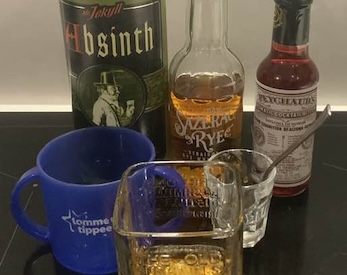
Sazerac Cocktail















Published on 8 August 2024 by Andrew Owen (3 minutes)
When it comes to cocktails, I’m a traditionalist. If it was invented after 1953, I’m not interested. At one former workplace, different teams were given the task of organizing the monthly drinks. When it fell jointly to production and IT, only one other colleague and I were interested in organizing it. So we blew the whole budget on drinks. I foolishly sent the receptionist to get the order and instead of bourbon we ended up with bought Southern Comfort. So rather than serve it, I went and bought a bottle at my own expense (the Southern Comfort eventually found its way into the punch). The theme we chose was the cocktails of Ian Fleming’s James Bond novels. We decorated the kitchen area with the then recently commissioned new set of Bond book covers from Penguin Books. It was the last monthly drinks to go ahead after the acquisition. And unlike all the preceding events, no-one who attended left to go to the pub. All the alcohol was consumed. And a year later, the book covers were still up. My research was incomplete, so we didn’t have the complete list of:
The first cocktail I started with was the Whiskey Sour because lemon and sugar do a decent job of disguising cheap whiskey. I discovered the Gimlet reading Raymond Chandler and the Mint Julep reading Hunter S. Thompson. I haven’t read the Fleming novels, so I didn’t discover the Sazerac until I watched Tremé. Famously, GQ food critic Alan Richman, who rubbished New Orleans and its restaurants, agreed to appear as himself in a scene written by Anthony Bourdain and have the official cocktail of New Orleans thrown in his face.
The International Bartenders Association recipe calls for cognac. The original cognac, from which the cocktail takes its name, was “Sazerac de Forge et Fils”. The invention of the cocktail is attributed to Antoine Amédée Peychaud, who is also the creator of Peychaud’s Bitters. Over time, bartenders began replacing the cognac with cheaper rye whiskey. The Sazerac Company was founded in New Orleans in 1869 to import the cognac. It has owned the rights to Peychaud’s Bitters since 1970. In 2006 it began producing its own brand of rye whiskey. And in 2016 it bought a French cognac distillery and revived the “Sazerac de Forge et Fils” brand. Absinthe was illegal in the US between 1912 and 2007, so in 1934 J. Marion Legendre created a substitute called Herbsaint. It is also currently produced by the Sazerac Company. When I make a Sazerac, I prefer to use rye whiskey (preferably Wild Turkey) and real absinthe: